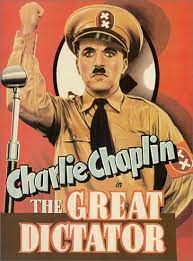
In 1908, during the First World War, a Jewish Barber (Charles Chaplin) was fighting as a soldier for the country of Tomainia. The Barber ends up saving the life of a fellow soldier, Schultz (Reginald Gardiner). In the process the Barber is injured and ends up in a coma. Twenty years later he finally awakens. Not realizing the twenty years have gone by, the Barber goes and opens up his barber shop.
In the meantime, Adenoid Hynkel (Charles Chaplin), comes to power. Hynkel is a ruthless tyrant who decides to persecute the Jews that live in Tomainia’s ghetto. The Barber and his friends are harassed by Hynkel’s military, the Stormtroopers. When the Barber tries to defend himself, the Stormtroopers start to hang him. The hanging is interrupted by Schultz. Schultz remembers that the Barber saved his life in the war. Being grateful he protects the Jewish ghetto neighborhood from the Stormtroopers. Life in the ghetto goes on smoothly for a while. The Barber even strikes up a romance with Hannah (Paulette Goddard), a laundress who lives next door.
Hynkel becomes more aggressive. He invades the ghetto and puts Schultz in jail. Many people flee to the nearby country of Osterlich, Hannah among them. Schultz and the Barber end up being sent to a concentration camp. Eventually the duo escapes and goes on the run. Hynkel begins a feud with his ally Benzino Napaloni (Jack Oakie), the ruler of Bacteria. Both want to invade Osterlich as part of their individual desire to rule the world.
“The Great Dictator” was released in 1940 and was written and directed by Charles Chaplin. Chaplin also starred in the film playing two characters, the dictator Hynkel and the Jewish barber. Chaplin also produced and scored the film. It was his first talkie. It is an American anti-war black comedy satire. In 1997, The Great Dictator was selected by the Library of Congress for preservation in the United States National Film Registry as being "culturally, historically or aesthetically significant".
Chaplin, most widely known as Charlie Chaplin, was a British comedian whose main claim to fame was his silent movie character “The Tramp”. He came to the United States and signed on with Keystone Studios in 1913. Chaplin died in 1977. In 1978 his body was stolen from the Corsier-Sur-Vevey cemetery. It was recovered 3 months later and buried in a cement vault.
The film was made during WWII; therefore, much of the humor is based on historical events of the time. Even so, if you are a WWII buff, or just somewhat informed about that time, you will be able to understand much of the subtle wit. It is also peppered with many of the skits that Chaplin used in his silent films. The movie is a caricature of Hitler and his main henchmen. For example, Garbitsch (Henry Daniell) represents Joseph Goebbels, and Herring (Billy Gilbert), represents Hermann Göring.
There is a poignant scene near the end where Chaplin intensely breaks the third wall and gives a speech about freedom and humankind. It is actually quite moving and appropriate, not only then, but now as well.
The movie was, of course, banned in Germany as well as a few Latin American countries where there was some Nazi activity and sympathizers. The British Government was ready to ban it because they had an appeasement policy with Germany. Then war broke out. After that it was everywhere in 1941.

